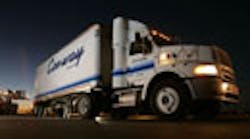ORLANDO. It didn’t take much convincing for vp of safety Bob Petrancosta to get Con-way Inc. involved in a long-term government-sponsored program to test a variety of new safety systems.
The LTL carrier Inc., joined a 54-month, $32.2 million dollar testing program sponsored by the Federal Motor Carrier Safety Administration (FMCSA) to analyze the effectiveness of forward collision warning systems, lane departure warning (LDW) technology, and blind spot detection (BDS) systems several years ago for a simple reason. Petrancosta said the program would not only save Con-way money, but save lives too.
“It’s not exactly rocket science why we’re doing this,” Petrancosta said here during a technical presentation at the Technology & Maintenance Council’s annual meeting. “First and foremost, this technology addresses highway safety issues, but not just for trucks. We share the road with all sorts of vehicles and it helps us deal with them.”
ORLANDO. It didn’t take much convincing for vp of safety Bob Petrancosta to get Con-way Inc. involved in a long-term government-sponsored program to test a variety of new safety systems.
The LTL carrier Inc., joined a 54-month, $32.2 million dollar testing program sponsored by the Federal Motor Carrier Safety Administration (FMCSA) to analyze the effectiveness of forward collision warning systems, lane departure warning (LDW) technology, and blind spot detection (BDS) systems several years ago for a simple reason. Petrancosta said the program would not only save Con-way money, but save lives too.
“It’s not exactly rocket science why we’re doing this,” Petrancosta said here during a technical presentation at the Technology & Maintenance Council’s annual meeting. “First and foremost, this technology addresses highway safety issues, but not just for trucks. We share the road with all sorts of vehicles and it helps us deal with them.”
The Integrated Vehicle-Based Safety System (IVBSS) study, conducted with support from the the University of Michigan Transportation Research Institute (UMTRI), is a two-phase program to see if all three technologies can be safely integrated into one package without overwhelming commercial truck drivers with too much information.
In spring 2008, Con-way made seven drivers available for a one-month pilot test of a truck equipped with the three systems to see if a longer test would be viable. The positive results convinced FMCSA to move forward with a longer-term test, involving 20 drivers and 10 International 8600 Series trucks running 24/7 – in effect generating the equivalent of eight years of data in a 10-month testing time frame. The longer field operating test kicked off early this month and Petrancosta expects to get a lot of valuable data.
“There are roughly 2.6 million rear-end crashes per year for all vehicles, which includes 27,500 fatalities,” he said. “All three of these systems together could prevent 67% of them. Based on that, it’s easy to see why we’re interested in this.”
An interesting part of the program, Petrancosta said, is the impact on driver behavior. Is there acceptance of it and, more importantly, will it be effective? “We’ve never tested these systems together and frankly it would be cost-prohibitive for us to do so,” he noted. “Being part of this program allows us to get access to it at a substantial cost savings.”
So far, drivers are responding well. Five of the original seven in the pilot test responded favorably to the technology and all of them are more acutely aware of the traffic around them, Petrancosta said.
For Petrancosta, one result from the pilot test validated the whole effort. “The test trucks record audio and video of the driver and in one case, a driver began to nod off, with the truck drifting out of his lane,” he said. “The LDW system alerted him, he got back in his lane and drove on without further incident. The technology did its job.”



